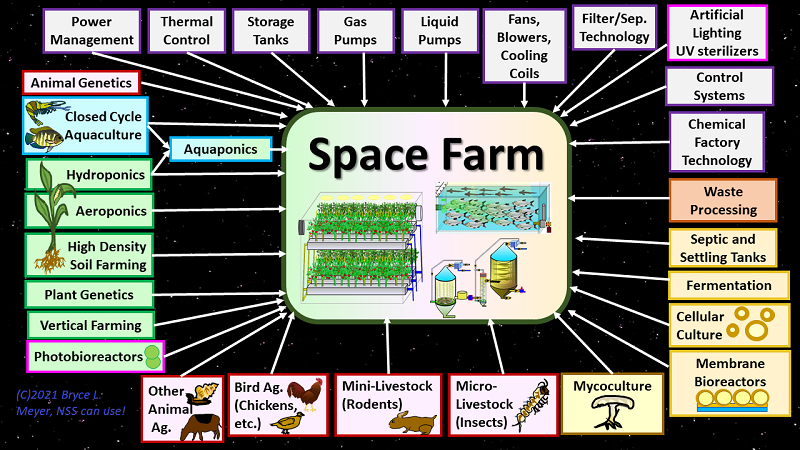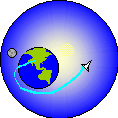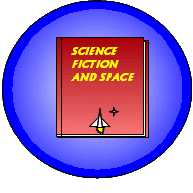Space Farm, Terraforming, Space Ecology, and Space Habitats Page
Space Farms, Terraforming, Closed Cycle Farming and Zero-g/microgravity farming.
Why settle space? TRILLIONS of Happy and Smiling Babies!!!
Here you will see my research and links for the future settler, space farmer, long range explorer, or anyone who wants to try closed cycle farming at home.
In order to make systems away from our first home, Earth, we need to think about a different kind of ecology, one that we will have to construct if a setlement or ship is to be at least partially self sustaining.

-
An introduction to closed cycle ecology.
- Terraforming: What is Earth-like?
- My NSS Space Ambassador Page
- LOOK FOR MY SPACE FARM TEXTBOOK!!! 430pp, over 300 illustrations and figures, for any technically interested person, readable by anyone, not just the academic community, early 2024
- Articial Intelligence (AI) for Space Agriculture at NSS ISDC 2024
- Space Settlement: Space Communities: The Difference Between Surviving and Living! at NSS ISDC 2024
- MY Archon 46 slides on space economics
- A look at atmospheric co2 and US crop production...means we need to enrich the air in space farms and study genetics for crops wrt gravity etc.
- NSS ISDC 2023: Student Panel Preso on Space Farming
- NSS ISDC 2023: Space Ambassador Track:Keto in Space: Menu Options and Food Processing for Vegan, Kosher, and Carnivore
- NSS ISDC 2023: Keto in Space: Protein Targeted Space Agriculture and How it Affects Overall Mass Flow
- NSS Space Settlement Jounal (2018 originally, numbers updated 2023) paper for the technical version of Energy needs for Space Farms
- an article about my work in space farms by Space Settlement Progress journal Nov 2022
- ARCHON 45: Mars as Breadbasket to Outer Solar System
- ARCHON 45: Coffee and Truffles on the Moon
- ARCHON 45: selected slides from other presos
- NSS ISDC 2022 Space Ambassador Track Presentation on Bioreactors
- NSS ISDC 2022 Space Settlement Track Presentation on Modern Farming and using this technology in Space Settlement
- Presentation to the Franciscan University Computer Club on using Genetic Algorithms for Space Farms
- AIAA ASCEND 2021 Session Teaching 5th Graders Space Farming
- Video of my NSS Space Forum Presentation 28 Oct 2021 Farming in Space for Future Space Settlements-Not just Glop and Salad!
- NSS Space Forum Slides 28 Oct 2021
- Archon 44 2 to 3 Oct 2021 Selected Slides from the 6 panels I was on (whew!)
- NSS ISDC 2021 Day 1 24 June Youtube...I have 2 presos in this set one on why I am a Space Ambassador (1:49), and on Space Farms 101 (4:16)
- My slides from the Space Farm Preso at ISDC 2021
- NSS Space Ambassador Presentation on the SImple Basics of Farming in Space April 2021
- St. Louis Space Frontier Gateway to Space 2020 Preso 12 Dec 2020 on The Messy Details of Going from Excrement to Entree (aka Going from Poop to Plate)
- St. Louis Space Frontier virtual preso 27 Mar 2020 Gardening for Home, Profit, and Space:Growing Food on Earth and in Space
- My talk on The Space Show 03 Dec 2019 on space farms and space life support
- Preso from NSS ISDC 2019 Bio-Sustainability Track: Aquaculture for Space Settlement (Space Farms)
- Preso from NSS ISDC 2019 Achieving Earth Independence Track: Food for (Small) Space Settlement(s) (Space Farms)
- AIAA SPACE 2018 Preso on Energy (electric power) Needs for Space Farms 17 Sep 2018 (Numbers are outdated fyi)
- St. Louis Gateway to Space 2018 Presentation 01 Sep 2018: Space Farming, Menus, and Biological Life Support: For Here and There
-
A Closed Cycle Prawn Experiment (in development)
(more tank experients to go here eventually---i have done LOTS of them....)
- A short 101 on high speed hydroponics (easy experiment)
- NSS ISDC 2018 24 May 2018 Presentation on Space Farms and Food Options... What's My Dinner
- NSS Space Settlement Journal Nov 2017 Space Farm article
-
A Space Resturant Economics preso I did at AIAA SPACE 2016
- See the NSS Space Settlement Journal for yet more
All about Budgets: Humans (and animals) breathe oxygen, consume water, consume proteins and carbohydrates, and many trace minerals and vitamins.
We exhale Carbon Dioxide (CO2), excrete water and salts (and other things).
It will always be a bit expensive to ship the inputs up the gravity well to people in settlements or space stations, so astronauts must also be farmers.
Plants and algae can convert our wastes and CO2 using light of certain wavelengths and water into food and oxygen.
Animals can also convert plants and algae (and in some cases wastes) into protiens.
Ships and stations have the tightest budgets...no more inputs other than light (others are very limited at best).
Settlements and bases on planets, moons, and other bodies have some inputs, but they might need some kind of transformation.
In any case, effecient farming (even on Earth) focuses on reuse, closing the cycle as much as possible.
A thing to note about making an ecosystem, it takes lots of work to keep it balanced in a way we want.
Near the sun we have ample sunlight (though maybe too much radiation..another topic), and likely ample energy (from solar, nuclear, etc.), so we assume we get these at need.
We will then need to balance what humans need to take in.
To do this mathematicaly we will need to find out how much each person takes in and lets out, and the same for any candidate species, including energy requirements (like heat, sunlight) and water. Ideally a profile of every species in the mix should be taken.
For now lets try w/o the math.
Lets assume we have a rotating space station (which provides some type of gravity)
So what species should we consider for an example:
-
Plants: Tomatoes are a very good start...they can grow in little or no soil, need less water then some other plants. Prickley Pairs might also fit into this model. Maybe some kind of legume if we have a very large area.
From either we get oxygen and food. We (humans) provide to either waste (including waste water such as from urine) and CO2.
Water will have to come from condensors (taking it from the air) and the toilet if it is a system of just us and tomatoes.
Energy would ideally balance out the losses in each cycle from Tomato to Person to Tomato...
Unfortunately, man cannot live on tomatoes alone (and who would want to?) so at a minimum other plants will be needed.
As a start, some water beyond what people bring in there bodies will be needed as well,
though an efficient system will minimize the starter water and any later water inputs (due to metabolic water loss...i.e. it takes water molocule to digest tomatoes and that water gets turned into cellular fuel..some is lost)
Ideally, you would need a suite of compatible plants, such as soyabeans, and maybe simple organisms algae. The count would depend on how much variety you want in your diet and what greenery you want to see around the station
(no reason one couldn't put mini tomato gardens everywhere there are people).
-
Personally, I like eating fish, shrimp, and other things too, and I think it also good to see them, and they can act as a buffer for plants.
In this case we need tanks.
Candidate species include bighead and silver carp (very good at filering wastes and can be raised very densely), prawns (also a good filter), and tilapia (can be seriously crowded, just like the carp).
One could then do a tilapia-tomato system (very common in home aquaculture fyi...), or a carp-shrimp-tilapia mixed arrangement, waste going through the plants/algae, then to the fishes. Dead leaves and plant wastes are great foods for the fishes mentioned too.
Tight management of the water is very important (water is recycled then on many levels), so closed tanks, or tanks in areas with hermetic seals to prevent water loss (like a garden area for the crew to enjoy plants and fishes).
If space is really limited, brine shrimp and krill could be used as well.
-
Another interesting crop for water-starved habitats is plant--mealworm or plant-mealworm-guinea pig. Yes, some of you might not like either one, but here is why they might be on the menu: Mealworms: eat anything, take very little space, and are very high in protien. On a long mission,
mealworms are good in that they reproduce very fast, and seem to be AOK with 0g. Guinea pigs: 1) are already a food source in space constrained high altitude areas (since habitats will be lower pressure then sea-level Earth, this is very good), 2) Eat anything, including leaves and mealworms, 3) don't need much water, 4) taste better then mealworms,
5) can live anywhere, especially if made hair-less or short haired...the mouse of the space-station house...Rabbits might also be a good crop, for those not into Guinea pigs. Waste from any of the animals (people too) are good fertilizer for the plant crops.
-
Core Technologies to space farms and settlements... we need some subset of these existing technologies to live long term in space, especially with space farms.
-
click for full size...

Back to top of this page
Terraforming: What is Earth-like?
To Terraform is to make a place Earth-like ('Terra' = earth).
Using various methods over (very) long periods of time places like the Moon or Mars could be made Earth-like, a home for humans away from Earth where Earth-like ecologies can flourish. No place will ever be exactly like Earth, but some places like Mars, given enough effort can become somewhat more friendly to people and Earth life. To look at terraforming one should look at what we call Earthlike.
Earth's atmosphere at sea level has 78% nitrogen, 20% Oxygen, and around 0.04% Carbon dioxide, the rest in trace gasses such as Argon, at 1 atmosphere pressure (around 14.7 pounds per square inch). Also Earth's air additionally has to 5% Water Vapor ( or up to 100% relative humidity, humans need water vapor to breathe easily). Humans and other animals can tolerate lower air pressures if need be (Incas live in Peru at over 10000 feet altitude, around 9 psi). The terraformed air will have to clear enough of poison gasses (ex: Carbon monoxide, hydrogen sulfide, chlorine, sufuric acid, etc.) to allow people to live also.
Outdoor temperatures should also be tolarable, espcially if we intend to have farms, praries, or forests. The temperature shouldn't swing beyond -40 C to +50 C (i.e. -40 F to 130 F) and should be between 3 C and 40 C (or between around 40 F and 105 F)for at least a few months a year at some region of the planet. The temperature range will need to match that of any Earth ecosystem or crop set we wish to grow. The Atmosphere should be thick enough to balance out temperature swings and store some of the day's heat.
Ideally, a Terraformed planet would also have some liquid surface water, with salinities of less than 37 parts per thousand ( or 3.7% by mass, for salt water animals, algae, and plants) and less than 8 ppt for freshwater organisms.
There will have to be some kind of way to limit radiation exposure, but allow enough light (in the 680 to 700 nm range) during the day to grow plants. How much light depends on the algae or plant, but your eyes already know how much on average. If the average person can't tell a black thread from white, it is likely too dark. More technically, at least .03 Watts per square meter. Too much radiation will cause mutation and destroy cells. On Earth, the atmosphere, ionosphere, and Van Allen belts (w/magnetic field) shield Earth life from lethal solar or cosmic radiation. Our terraformed planet will need either a thick atmosphere, or some methods to keep radiation exposure within survivable levels. Radiation can some from soils and minerals (like Uranium) as well, and these will have to be livable as well.
Soils: Soil on Earth that grows plants chemically balanced (water, oxygen, acid/bases, minerals), and is actually a complex ecology itself, having bacteria, fungus, many micro-organisms and worms. Chemically balanced soil is the starting point. Various earth organisms can break it up from there. Even solid rock can be broken up by lichens over a long period of time. Plants, algae, and cyanobacteria in turn can build oxygen levels in the atmosphere.
Back to top of this page
© 2021 Bryce L. Meyer all rights reserved...














